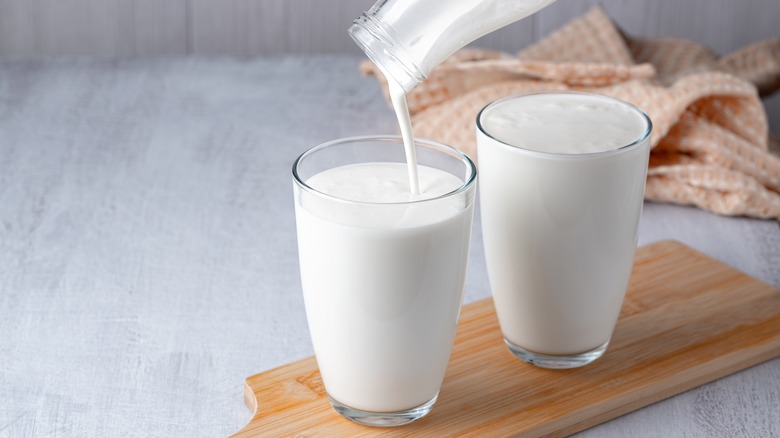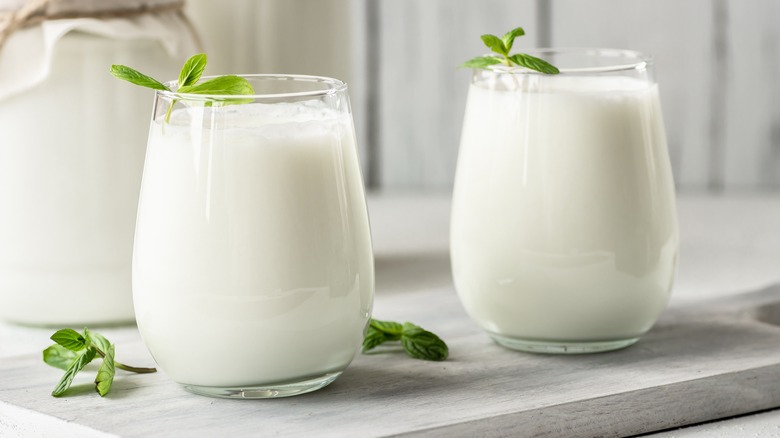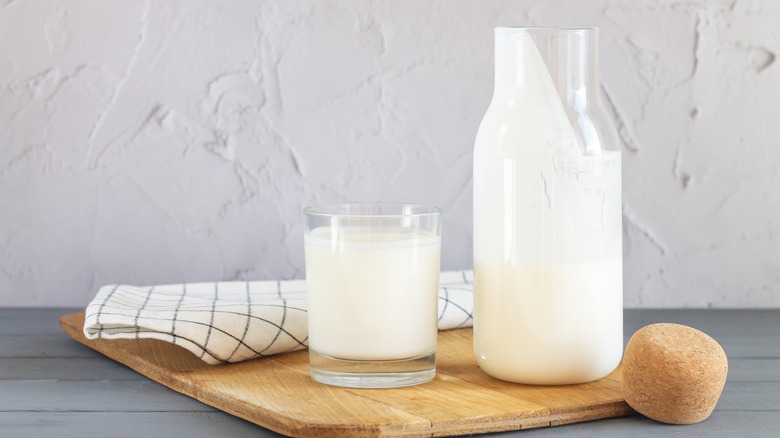Here's How Long You Can Use Buttermilk After Opening
There are so many reasons why a bottle of buttermilk deserves a permanent spot in your refrigerator. You can whisk it into pancake mix for a fluffy, pillowy rise; add it to a batter to make the crispiest shell on fried chicken; or pour it into a salad dressing for a creamier body with a hint of tang. However, since this dairy product isn't quite as widely-used as milk or cream, you might not know how to store it or when it goes bad.
Buttermilk is basically fermented milk. It has a thick, somewhat lumpy texture and tart flavor due to lactic acid produced by the fermentation process. You may know that fermented foods can last a long time, and lactic acid does inhibit the growth of bacteria, but unlike pickles or miso, buttermilk doesn't last for months. An opened container will only stay fresh for two weeks when stored in a refrigerator, and for up to three months if kept in the freezer.
This shelf life may not be super long, but gives you enough wiggle room to use up your buttermilk. However, its shelf life could be much shorter if you don't store it properly. Factors like drastic temperature changes or improper handling can cause this product to spoil way before two weeks are up. Learning to store it the right way, and how to tell if it's bad, can save you the misfortune of tossing out a mostly-full carton.
Signs that your buttermilk has gone bad
Whether you make homemade buttermilk or buy it, it needs to be stored in the fridge in an airtight container and thoroughly examined before each use. Try not to store it on the door of the fridge, which tends to be the warmest area with the most temperature changes, which speeds up spoilage. Before using, look for signs of mold on the buttermilk or its container, as well as yellow discoloration. The buttermilk's naturally tangy aroma will also turn more overtly sour as it deteriorates.
The lumps in buttermilk should also be small enough to break down under a spoon or whisk. Spoiled buttermilk, on the other hand, will have a very thick, slimy consistency, with lumps so large that the substance is more solid than liquid. Lastly, buttermilk naturally separates into solids that sink to the bottom and liquid whey that floats on top, but when fresh, all it needs is a quick shake to combine the two parts. When shaken, bad buttermilk will split into big chunks similar to cottage cheese, and these won't mix back into the liquid.
While you ought to rely on visual and olfactory signs to determine if your buttermilk is bad, you could taste test it, if you're okay with a risk of consuming bacteria. Fresh buttermilk has a creamy, buttery flavor with a hint of tang, but becomes more sour as it sits.
Is freezing worth the longer shelf life?
Buttermilk's two-week shelf life can be extended to three months if stored properly in the freezer, but the downside is that it won't be the same after thawing. It tends to separate when thawed and takes on a lumpy and gritty texture. If you're hoping to use buttermilk in a smoothie or salad dressing, this mouthfeel can lead to unpleasant results. However, if you're using buttermilk in cake batter, a meat marinade, or other "cooked" applications, the thawed and frozen stuff can work fine. It will still have the acidity and fat that adds tenderizing and enriching properties to cooked dishes.
While an opened, half-used container of buttermilk can be frozen in its original carton or bottle, as long as there's enough extra space for the liquid to expand as it freezes, you might consider pouring it into an ice cube tray instead. This will give you small, convenient cubes that you can pop out as needed — no need to hack away at a giant block of frozen buttermilk every time you want some. In any case, transfer frozen buttermilk to the refrigerator to thaw overnight before you go ahead and use it in your recipes.



